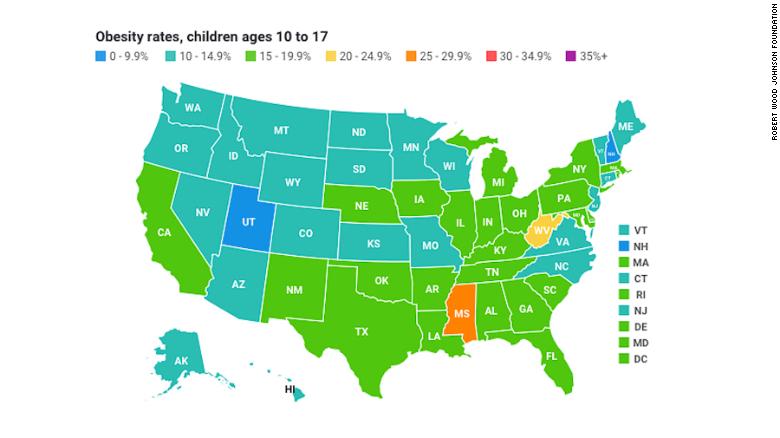Black and Hispanic Youth – Targets for junk food ads
 Black and Hispanic children are being targeted with unhealthy advertisements, a new study finds. “Junk food comprised 86% of ad spending on black-targeted programming and 82% of spending on Spanish-language television in 2017.”
Black and Hispanic children are being targeted with unhealthy advertisements, a new study finds. “Junk food comprised 86% of ad spending on black-targeted programming and 82% of spending on Spanish-language television in 2017.”
Not only are these companies targeting these groups, but they are targeting them with their unhealthiest products.
A report by the Rudd Center, a research and policy group working to combat childhood obesity, looked at the advertising efforts of 32 food and beverage companies that spent upwards of $100 million just to reach children in 2017.
Researchers compared these findings to a study done in 2013 and they found a big disparity between what minority youths was exposed to compared to white children.
“In 2013, black youth saw 70% more food-related ads than their white peers. By 2017, black children saw 86% more than white kids, and black teens saw 119% more than white teens, the study found.”
Although there has been a movement towards offering healthier options, researchers believe that these efforts were more PR than put into advertising for children, particularly within Hispanic and Black communities. Only 3% of ads for healthy options went towards advertisements, 1% of that went to black-targeted programming and little to none to Hispanic children. This means that Spanish-language television didn’t have ads for healthy food, instead had up to 20% for candy.

“At best, these advertising patterns imply that food companies view Black consumers as interested in candy, sugary drinks, fast food, and snacks with a lot of salt, fat, or sugar, but not in healthier foods,” said Shiriki Kumanyika, one of the study’s authors and chair of the Council on Black Health, in a written statement.
Kumanyika believes these companies are contributing to an increased risk in obesity, diabetes and high blood pressure in these communities. “According to the US Centers for Disease Control and Prevention, nearly 26% of Hispanic youth and 22% of black youth were deemed obese, versus 14% of whites and 11% of Asians. The worst off, though, were Hispanic boys at 28% and black girls at more than 25%.”
CNN attempted to contacted the companies who were studied in this report but all denied to comment except Hershey, which responded that the data was “not accurate.” Claiming their is a difference between “reaching” and “targeting” viewers, and they are “targeting” adults or decision makers in the household not their children.
Researchers are hoping that food manufacturers will consider the effects of their advertising on health and aim to promote healthier food to children all over. Even if the ads are being “targeted” toward adults, children are often influenced by the choices their parents make.
It is important to support health equity for everyone, no matter where they are from. Marketing does have power and can improve health by promoting healthier products.
To learn more: “Black and Hispanic youth are targeted with junk food ads, research shows” – CNN
Sign up for Diabetes Blog Bytes – we post one daily Blog Byte from Monday to Friday. And of course, Tuesday is our Question of the Week. It’s Informative and FREE! Sign up below!
[yikes-mailchimp form=”1″]Teens weight self-perception affects health
 American teenagers who incorrectly perceive their weight are more likely to have unhealthy eating habits and be less active overall. Teenagers who accurately perceive their weight are more likely to make healthy choices and not take part in risky diets.
American teenagers who incorrectly perceive their weight are more likely to have unhealthy eating habits and be less active overall. Teenagers who accurately perceive their weight are more likely to make healthy choices and not take part in risky diets.
The study analyzed data from over 12,000 American teens, 32% of which were obese or overweight.
- “Nearly 23 percent of the teenagers studied, misjudged their weight.
- 11.6 percent incorrectly believed they were overweight, and
- 11.3 percent believed they weighed more than they should while thinking it’s healthy and underestimating their weight.”
- Researchers also found the girls were more likely to misperceive their weight then boys.
Teens who incorrectly believed they were overweight were less likely to drink fruit juice or milk, eat fruits, or have breakfast on a regular basis.
Teens who were actually overweight or believed they were overweight were least likely to get 60 minutes of physical activity a day, five days a week, the researchers noted.
This misperception of weight strongly correlated with adult obesity later in life. “Early childhood interventions to promote appropriate weight-related perception and weight management could have a lasting impact on chronic disease burden, in addition to preventing unhealthy diet and physical inactivity in youth,” he suggested.
Weight perception has also been linked to eating disorders, which are a leading cause of morbidity in American teens. Schools are now encouraged to provide education on eating disorders, weight misperception and providr examples of healthy behavior.
Researchers also believe that developing a regular exercise routine early can help a child maintain health habits into adulthood.
To learn more: Teens Often Off the Mark About Their Weight, With Unhealthy Results – HealthDay
Sign up for Diabetes Blog Bytes – we post one daily Blog Byte from Monday to Friday. And of course, Tuesday is our Question of the Week. It’s Informative and FREE! Sign up below!
[yikes-mailchimp form=”1″]“Most U.S. kids not meeting sleep, exercise and screen time targets”
A new study suggests that only 1 out of every 20 teens in America is getting the physician recommended amount of sleep, exercise and screen time (time spent on devices).
The recommended amount of exercise for a teenager is 1 hour of moderate to vigorous exercise per day. Screen time should be limited to 2 hours per day. “Kids ages 6 to 12 old also need 9 to 12 hours of sleep, while teens need 8 to 10 hours nightly.”
The study concluded that too little sleep and exercise and too much screen time can lead to chronic health issues such as obesity, mental health problems, poor academic performance and unhealthy behavior such as smoking and drinking.
However, these recommendations have been increasingly difficult for children and teenagers to meet. Similar to adults, it can be hard to meet all three requirements at the same time, versus focusing on one.
For the study, 59,000 kids were surveyed over four years. “Overall, just 3 percent of girls and 7 percent of boys spent the optimal time sleeping and being physically active while limiting screen time.”
The three factors seem to support each other. More exercise led to better sleep and less screen time. However, less exercise led to more screen time and less sleep.
The study urges parents to encourage their children to engage in physical activity that can help with sleep patterns. Schools also impact sleep due to early start times.
“Sleep and physical activity are two pillars that should not be sacrificed in childhood,” said Jonathan Mitchell of the Children’s Hospital of Philadelphia and the University of Pennsylvania.
Sleep is often sacrificed for other activities including spending time on cell phones, computers and watching TV. Teens and parents should be more cognizant of bedtime and focus on finding a balance between, sleep, exercise and screen time.
To learn more: Most U.S. kids not meeting sleep, exercise and screen time targets – Rueters
Sign up for Diabetes Blog Bytes – we post one daily Blog Byte from Monday to Friday. And of course, Tuesday is our Question of the Week. It’s Informative and FREE! Sign up below!
[yikes-mailchimp form=”1″]Less beef, more beans. New world diet.
A report attempting to overhaul the universal “diet” says a hamburger a week is about as much red meat you should be consuming. Eggs should be limited to less than four a week and dairy, one serving per day.

A panel of nutrition, agriculture, and environmental experts recommend a plant-based diet. This recommendation stems from many published studies that link red meat to health problems and livestock farming to environmental issues.
The report highlights the deadly effects meat production is having on the environment. “Producing red meat takes up land and feed to raise cattle, which also emit the greenhouse gas methane.”
The report was organized by a Swedish-based nonprofit seeking to improve the food system. They believe a “great food transformation” is necessary by 2050. They also believe their recommended diet could be inclusive to all cultures around the world.
Of course a major obstacle is convincing cultures who are traditionally meat and cheese heavy, to make the shift.
“The diet encourages whole grains, beans, fruits and most vegetables, and says to limit added sugars, refined grains such as white rice and starches like potatoes and cassava. It says red meat consumption on average needs to be slashed by half globally, though the necessary changes vary by region and reductions would need to be more dramatic in richer countries like the United States.”
Scientists
Advice to limit red meat isn’t a new concept and has been linked to lowering high saturated fats. However, the meat and dairy industries argue that their products carry important nutrients necessary for a healthy diet.
A report conducted by the United Nations, concluded that livestock is responsible for 15% of gas emissions that warm the climate. International Climate Researcher, Robbie Andrew, believes that utilizing practices that help the animal to grow bigger faster may help decrease emission, however the animal will still produce methane, which is a powerful greenhouse gas.

People could replace beef with chicken or pork, which do have few emissions, however plants have one of the smallest carbon footprints over all.
The report itself does lay out the “optimal” diet for both environment and health. However, researchers understand the battle it may be to convince policy makers, food companies and those set in traditional cuisine.
Enjoy our Plant Based Resources Library
To learn more: Less beef, more beans. Experts say world needs a new diet – AP
Sign up for Diabetes Blog Bytes – we post one daily Blog Byte from Monday to Friday. And of course, Tuesday is our Question of the Week. It’s Informative and FREE! Sign up below!
[yikes-mailchimp form=”1″]
New screening could predict type 1 diabetes risk in babies

A new screening may be able to detect Type 1 Diabetes risk in infants. T1DRGS2 is a new risk score test that has shown twice the efficiency of all existing tests for Type 1 in babies.
“Type 1 has a strong genetic element that was not measurable in the past.” Richard Oram, a researcher at University of Exeter, said in a press release. “Measurement of the type 1 diabetes genetic risk score could help predict who will develop the condition from early life could help with research into potential early life interventions, and with classifying diabetes correctly at diagnosis.”
The current test for Type 1 is both expensive and hard to do with children. This new test detects development even into adulthood and the difference between Type 1 and 2. The researchers examined genetic interactions in over 65,000 people with Type 1 diabetes.
The test allows for early detection that can help parents look for symptoms. Also those with the greatest risk of developing in the future, can participate in studies to delay or even prevent the diagnosis.
“It’s exciting to see the power of genetics being harnessed to help predict who might develop type 1 diabetes in the future, particularly from a young age. If successful, this approach could help to reduce someone’s risk of being misdiagnosed or developing complications during diagnosis,” said Anna Morris, Assistant Director of Research Strategy and Partnership at Diabetes UK and study author.
This research can also provide insight on what we can do to prevent the disease or at least slow down it’s progress.
To learn more: New screening could accurately predict type 1 diabetes risk in babies – UPI
Sign up for Diabetes Blog Bytes – we post one daily Blog Byte from Monday to Friday. And of course, Tuesday is our Question of the Week. It’s Informative and FREE! Sign up below!
[yikes-mailchimp form=”1″]Higher risk of alcohol and mental health problems in diabetes – Mindful Monday
A new study suggests a concerning correlation between mental health problems and diabetes. The study, conducted by Universities of Helsinki and Tampere and Helsinki University Hospital, investigated the relationship between diabetes the the risk of death due to mental health problems.
People with diabetes have an increased risk of cardiovascular events, cancer and kidney disease. However, this is not the only concerning health risk that is associated with diabetes.
One study published in the Journal of Medicine and Life in 2016, for instance, discovered that the occurrence of depression in people with diabetes is two to three times higher than in other individuals.
Many people with diabetes have spoken out about their mental health problems associated with the disease. The study suggests that these mental health issues put those with diabetes at a greater risk of death due to suicide, alcohol and accidents. Interestingly, those who required self-injecting insulin were at an even greater risk!
The pressure of monitoring and balancing glucose levels, “combined with the anxiety of developing serious complications like heart or kidney disease may also take their toll on psychological well-being.”
All of these findings speak to the fact that mental health assessment and support should play a greater role in disease management. These problems can be managed, but only if they are communicated first.
See our Psycho-social Resourse Page for mental health screening tools
To learn more: Higher risk of alcohol- and suicide-related death in diabetes – Medical News Today
“Diet high in vitamin C could protect against gestational diabetes”
A new study finds that women who incorporate more vitamin C into their diets, lower their risk of developing gestational diabetes.
Nianhong Yang, PhD, a professor and director of the department of nutrition and food hygiene at Tongji Medical College, Huazhong University of Science and Technology in Hubei, China, studied the data of over three thousand pregnant women during the gestational period. Participants provided lifestyle information through a questionnaire and vitamin C supplement intake and dietary behavior were assessed via in-person interviews.
“The researchers defined dietary vitamin C intake into three groups: inadequate (< 115 mg per day), adequate (115 mg per day to 200 mg per day) and above adequate (> 200 mg per day).”
During the study 344 women developed gestational diabetes and 744 women had “inadequate” vitamin C intake. “The primary source of dietary vitamin C consumption was leafy green vegetables, cabbage and chili, along with other fruits and vegetables.”
The study found that women with above adequate vitamin C intake were less likely to develop gestational diabetes. However, women with inadequate had a negative correlation with gestational diabetes.
To learn more: Diet high in vitamin C could protect against gestational diabetes – Healio
Sign up for Diabetes Blog Bytes – we post one daily Blog Byte from Monday to Friday. And of course, Tuesday is our Question of the Week. It’s Informative and FREE! Sign up below!
[yikes-mailchimp form=”1″]
“Remembering Quincy, a Beloved Koala with Type 1 Diabetes”

In the summer of 2018, the Scripps Whittier Diabetes Institute and San Diego Zoo teamed up to help Quincy, a koala, manage his diabetes. Quincy was well-known for being diagnosed with diabetes and then treated with a CGM (continuous glucose monitor).
“Working with Quincy allowed us to extend our digital technology into an entirely new population,” said Athena Philis-Tsimikas, MD, corporate vice president for the Scripps Whittier Diabetes Institute
Interestingly, Dr. Tsimikas reported that working with Quincy gave additional insight into working with someone who was unable to speak, like a person who is unconscious due to hypoglycemia or a small child.
The CGM transmitted Quincy’s blood glucose levels to an app, which helped caretakers manage his Diabetes. Prior to using the CGM, the zoo staff would have to prick Quincy many times a day.
Quincy passed in late 2018 due to pneumonia but continues to be a beloved mascot for those with diabetes.
“Hopefully our experience with Quincy provided new approaches to the Zoo, not only for marsupials but for other species that may develop diabetes and need ongoing therapy for the future.”
To learn more about how technology was used to help Quincy the koala: Remembering Quincy, a Beloved Koala with Type 1 Diabetes
Sign up for Diabetes Blog Bytes – we post one daily Blog Byte from Monday to Friday. And of course, Tuesday is our Question of the Week. It’s Informative and FREE! Sign up below!
[yikes-mailchimp form=”1″]








